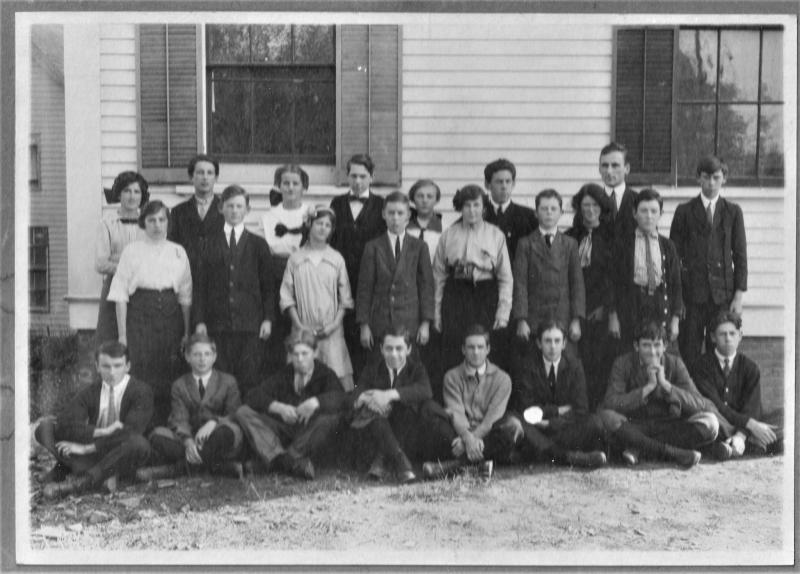High Schools

The mid-1870s saw the creation of high schools in Boothbay with two-year high schools soon in three grammar schools: Barters Island, Boothbay Center, and East Boothbay; the Harbor area had a four-year high school pretty quickly. But high school terms stayed sketchy and the standards weren't high, since the scholars were being taught by grade school teachers. In Boothbay the 1910s brought more stringent rules requiring a dedicated teacher and a room for high school classes despite increased taxes to pay for it. The Boothbay region was a fairly poor area for most of its existence, and the townspeople did not welcome improvements that brought consequent tax increases. At that time, the Harbor's high school rooms were deemed inadequate, but the townspeople wouldn't okay a new building. Add-ons and/or auxiliary buildings were used to get by.
Two-Year Highs
There were various solutions for Boothbay scholars to get the full four years of high school. 1) The whole family could move to another town for two to four years, as Cecil Pierce's family did about 1920, moving to Richmond for his last two high school years. 2) Scholars could go to distant or near secondary schools, such as Gould, Kents Hill, and so on. Many went to Lincoln Academy in Newcastle by steamer, then boarding up there when the river froze. 3) If there was room (usually not much) at the Harbor's high, Boothbay kids could go there for the last two years. In 1934 of the Harbor's 191 high school scholars, only 35 were from Boothbay. But there still were problems for those who were able to go there. According to Paul Adams (now 91), who grew up in East Boothbay, his "two older brothers went to school over in Boothbay Harbor. The first one was Merrill. He was the highest ranking kid in the class, but superintendent Harold Clifford said he couldn’t be valedictorian because he'd only been a two-year student earlier in East Boothbay. Then the next year my second brother Willard did the same thing, but no way" could he get the honor.
Hazel Poore
Hazel McCobb Poore (born 1909) attended school at the Center, and she talked to me about her life at length in the late 1980s, really for years. "The first year of high upstairs I had John Welsh. Well, the townspeople kept talking and kept talking about taking the big part that was on the southern side of the upstairs and the cloak room and take that and fix it so they could make it four years of high. Boothbay Harbor had so many scholars, it was getting to the point where they couldn’t take any of the high school scholars down there from Boothbay." But the effort never succeeded.
Many scholars didn't pursue either two-year or four-year high school, going to work after grade school. They followed the old tradition of schooling until they could do a day's work farming, milling, fishing, or managing a home. The two-year high schools lasted in Boothbay for decades.
Consolidation and Polly Hardwick
Consolidation of high schools came very slowly and painfully in the mid-1950s. Despite the effort having been underway since early 1951, it had been a struggle to accomplish, with Harbor trustees walking out of at least one meeting and bad feeling on all sides. The memory of the bitter 1889 breakup of the towns when the Harbor left Boothbay was still fresh in many minds. The result was that some Boothbay voters still wanted nothing to do with the Harbor. And Boothbay and Southport thought they were asked to contribute more than was fair.
At a consolidation meeting, Polly Hardwick made memorable remarks on the perceived abuse of Boothbay by the Harbor. Her words were aimed at Harbor attendees and committee members: "You bury your dead on us, you dump your trash on us, and now you want us to build you a school." It pretty accurately reflected the level of antagonism that had arisen.
Stalemate and Resolution
It was a stalemate for a few years, so the Kenney Field area, bought for a future school site, was finally sold. Things eventually got back on track in 1954 and a site on the meadow was chosen. Late that year, tons of rocks, blasted from the future school's location, were dumped in the waters of the harbor to extend the parking lot near the footbridge. The new Boothbay Region High School replaced the Boothbay Harbor High School on School Street and the high school rooms at the Center and East Boothbay. (Barters Island started sending its high schoolers to the Center in 1933.) The new high school opened in January 1956.
The final consolidation of the Boothbay and Harbor elementary schools took place about 20 years later. It was formally proposed in 1972 and slowly wound through the systems with much less controversy. Bids went out in 1975 and it opened in fall 1977 at a cost of $3,500,000, resulting in the closing of the East Boothbay, Boothbay Center, and Harbor schools. My older son knew no other elementary school after he started school there in 1977, and he had a passing familiarity with all school children in Boothbay and Boothbay Harbor, something I didn't have in grade school. But the Center and East Boothbay seemed more lifeless during the day. The merging and consolidation rife in modern-day life has some downsides.

























